Hello everyone!
It has been a busy past several weeks as the graduate students prepare for field work this spring. Bees have started to emerge in southern Ohio (at least on the warmer days). Some of our collectors have even gotten to start collecting for the specialist bee project since enough stuff has started to emerge!
Amber is looking at specialist bees and their nesting habitats. Cheyenne is looking at bumble bees and the impacts of spring floral resources. Lee is the third graduate student in the lab who is finishing up her thesis and will be defending soon!
The Denman Forum:
On March 8th, our undergraduate student Eleanor competed in the Denman Forum at OSU. She presented on the cool hover flies that were bycatch in the bee bowl project and ended up winning first place in the Animal and Insect Sciences category! A copy of the poster can be found here: OhioSyrphidaeBycatch_DenmanForum2021

Dr. Goodell (left), MaLisa (middle-ish), and Eleanor (right)


I was particularly excited to see all of our bee bowl sample sites mapped on the poster. You can see how wide our coverage of the state was for the project, so thank you again to everyone who got their kits turned in to us! We will make a similar map for our bee project eventually.
Lasioglossum workshop:
We had a small amount of grant funds devoted to identification services, so we paid Rob Jean to visit our lab to give our lab a small workshop on some of the harder Lasioglossum bees. Rob brought reference specimens of over 50 species of Lasioglossum bees and had us key them out to try to guess the correct identifications. When we would run into a confusing couplet he would explain his interpretation of that character as some of the identification characters are somewhat ambiguous. We all found the workshop rather helpful and will use this new knowledge to get through the many remaining Lasioglossum specimens from the bowl survey. A majority of my time over the last few weeks has been practicing with these keys and trying to gain more confidence in this rather frustrating group. We expect to find somewhere over 50 species of Lasioglossum in Ohio, so we have a lot of work ahead of us.
Below I will throw some images with some of the microscopic characters of some of the species that we covered. This will mostly be a resource for those in our lab who plan to go back and identify our specimens here, but I figured others might appreciate seeing the level of detail we need for this rather tricky group. Below is going to be a bit messy and somewhat un-annotated, and probably some typos, so feel free to stop here if you don’t plan on getting into identification of this hard group.
All for now,
MaLisa
Lasioglossum workshop images and notes:
We used the Gibbs keys, mostly sorting stuff out with the 2011 Revision of the metallic Lasioglossum (Dialictus) of eastern North America (Hymenoptera: Halictidae: Halictini) and also taking into account a few of the more recent changes (mitchelli to hitchensi, clarifications of the tegulare group, etc)
Note the below notes are not comprehensive of all possible species, but at least cover a few of the characters of some of the species we might expect. I also didn’t take notes on every single species that we went over, so some of the workshop species are missing from the below notes.
versans – lack acarainial fan (no photo, but this is really distinct)
disparile – distinct additional band of hairs on abdomen, looks like someone kissed it and left a lip stain

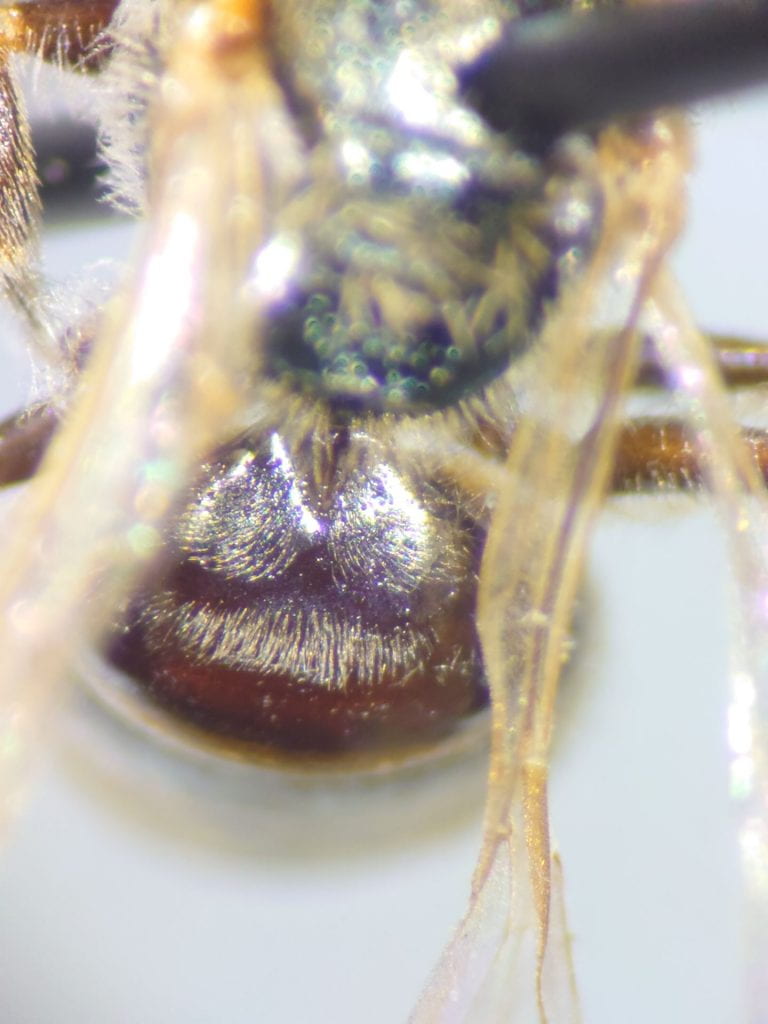
illinoiense – distinct procoxa and also propodeum sculpturing (procoxa looks like a scone to me) (did not photograph)
foveolatum – very distinct supraclypael area that is darker in the center and bulging, also parapsidal line thick and indented


parapsidal lines larger than normal, deeply indented
anomalum – 2 submarginal cells (smallish, acarinial fan complete)
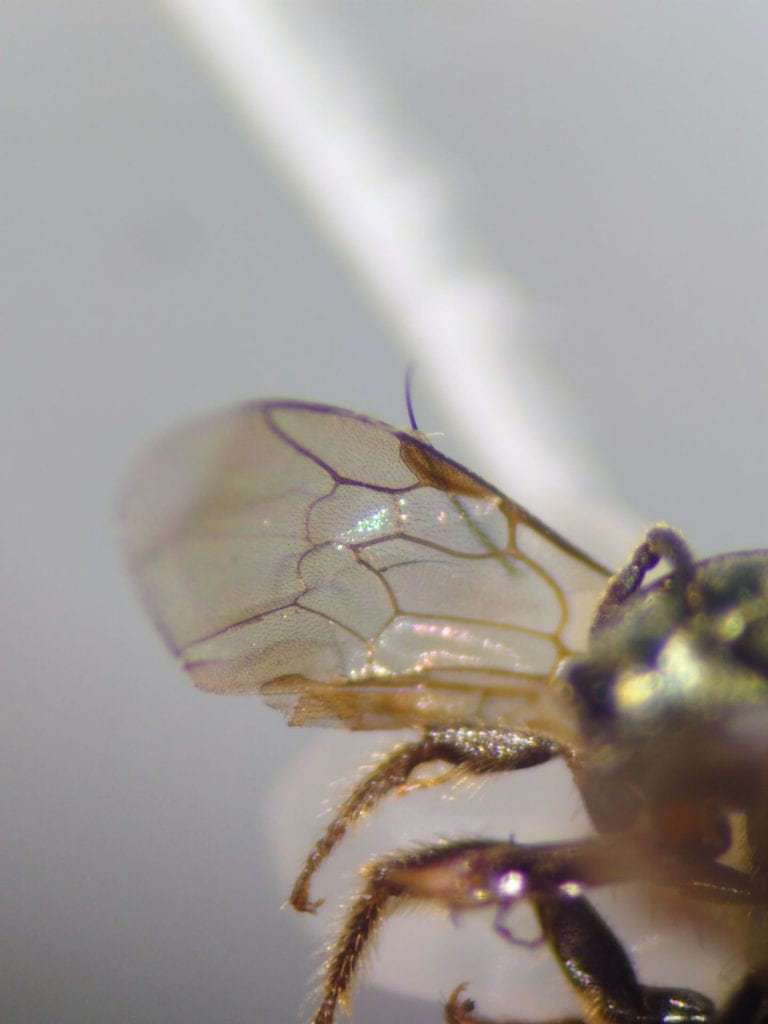
Be sure to check the other characters in addition to submarginal cell number, as sometimes specimens that should have 3 cells will spontaneously lose a vein on one wing and thus look like it only has 2 cells


imitatum – distinct hairs on last abdominal segments, body size small

This specimen is a bit gunky, but the small body size and distinct hairs on the last two segments help identify it.
Orange Butt group: select species
vierecki – orange butt, dense scutal hairs


pictum – orange butt, dark clypeus, mesepisternum punctate, postgena polished


postgena polished and reflective
arantium – orange butt, dark clypeus, mesepisternum rugose-punctate, postgena DULL due to microsculpture



tegulare group – Annoying to ID to species, but the group is defined by having a distinctly bean shaped tegula (similar to Augochloropsis) – (did not photograph)
mesepisternum shining – ellisiae – very hard to see tbh….
mesepisternum DULL, inner hind tibial spur with 3 branches, and paraoculare area with sparse tomentum – tegulare (but supposedly Gibbs will say everything in OH is ellisiae)
other tegulare group species unlikely in our area
Coarsely scupltured propodeum group
bruneri – Hypostomal carina widely divergent and protrochanter with anterior surface excavated. hypostoma carinae produced (did not photograph, but we have several specimens)
reticulatum – Hypostomal carina divergent, but NOT produced. protrochanter not excavated (did not photograph)
Hypostomal carina PARALLEL, mesoscutum COARSLY rugose laterally (also thorax dark bluish) = hartii – wetland associate


hypostomal carina parallel

Hypostomal carina parallel, mesoscutum punctate laterally, transverse NOT interrupted medially, tegula punctate (but hard to see imo), mesosoma bluish = nymphaearum –> Now called oceanicum!!


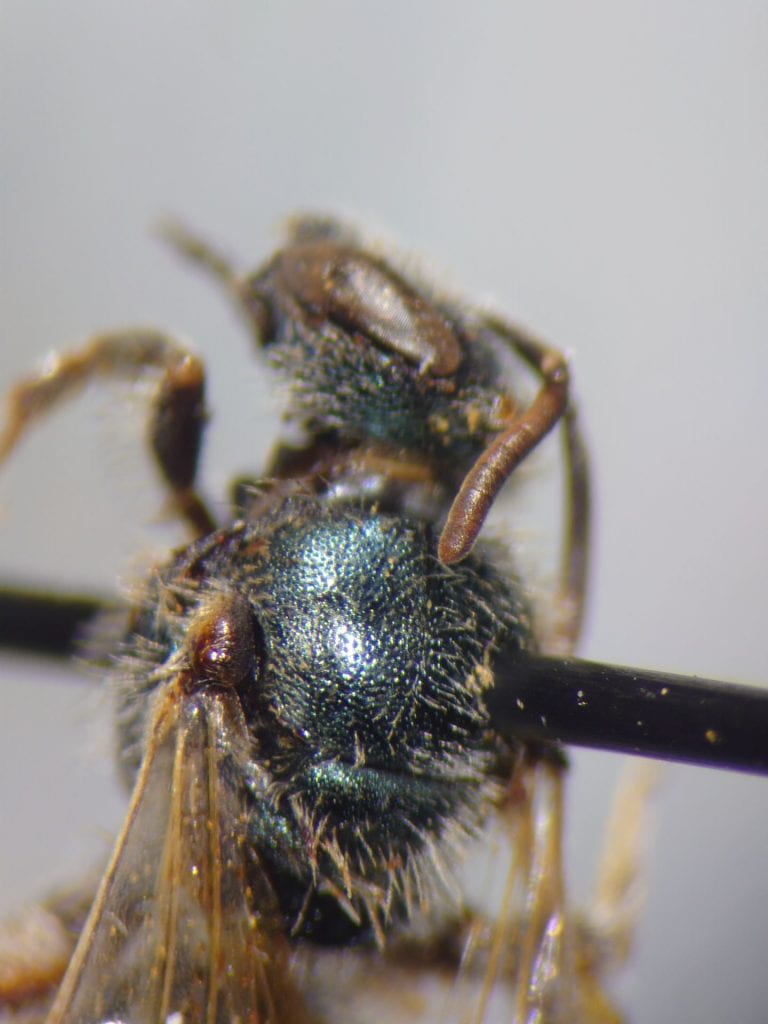
Hypostomal carina PARALLEL, mesoscutum punctate laterally, transverse propodeal carina interrupted and wings veins pale, mesosoma bluish = albipenne (did not photograph, but we get a lot of these)
Hypostomal carina parallel, mesoscutum punctate laterally, transverse propodeal carina interrupted, wing veins DARK, pitting on scutum denser than albipenne =cressonii (did not photograph, but we get a lot of these)
scutum SPARSE lateral of parapsidal lines; mesepisternum SMOOTH with distinct punctures; larger overall size, minimal hair on abdomen and dark black, and a nice coarse propodeal carina = nigroviride (forest associate) (did not photograph, but we have a few of these)
scutum SPARSE lateral of parapsidal lines; mesepisternum SMOOTH with distinct punctures; smaller compare to nigroviride, small amount of hair on abdomen, propodeal carina very small and only at the base = obscurum (also forest associate) (did not photograph, but we have a few of these)
Scutum sparse (but could go either way in key since so hard to see); frons punctures dense, size small, LONG head; scutum TESSELATE (v distinct), t1 acarinial fan dense = coreopsis. Note that longifrons has a longer head and supposedly a sparser t1 fan, but longifrons is southern

acarinial fan complete

Body size relatively small
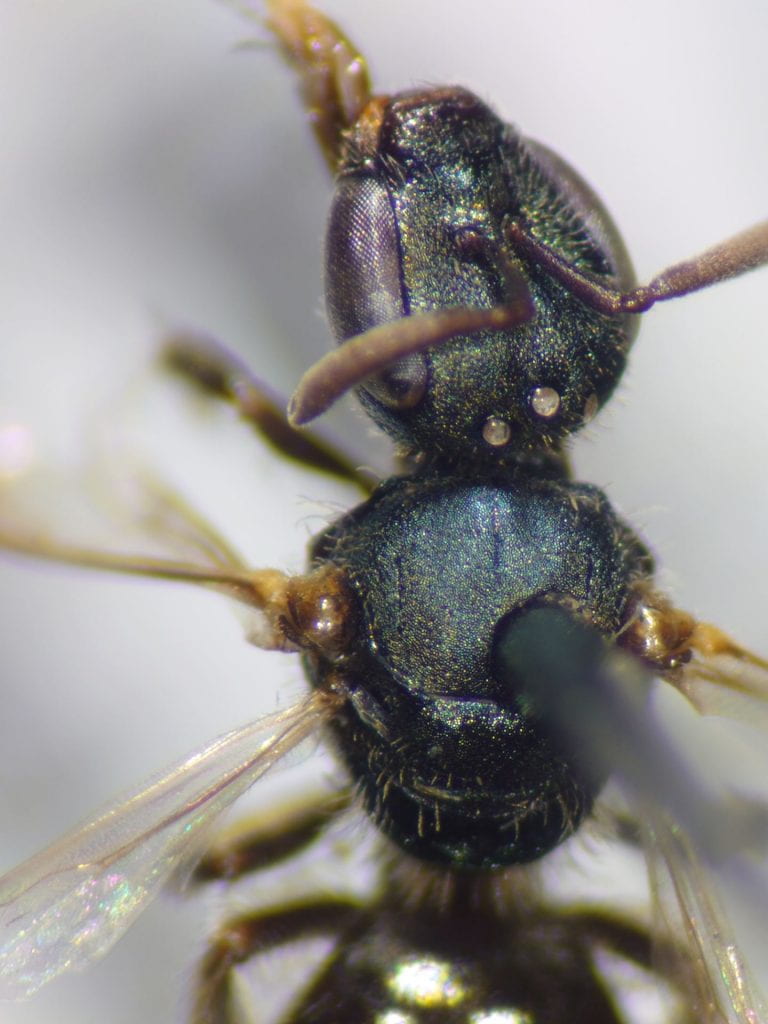
Scutum distinctly tessellate
scutum sparse lateral of parapsidal lines, head normal, scutum normal, frons punctures dense, clypeus weekly protruding below suborbital line, propodeal dorsolateral slope imbricate (vs rugose) = lineatulum

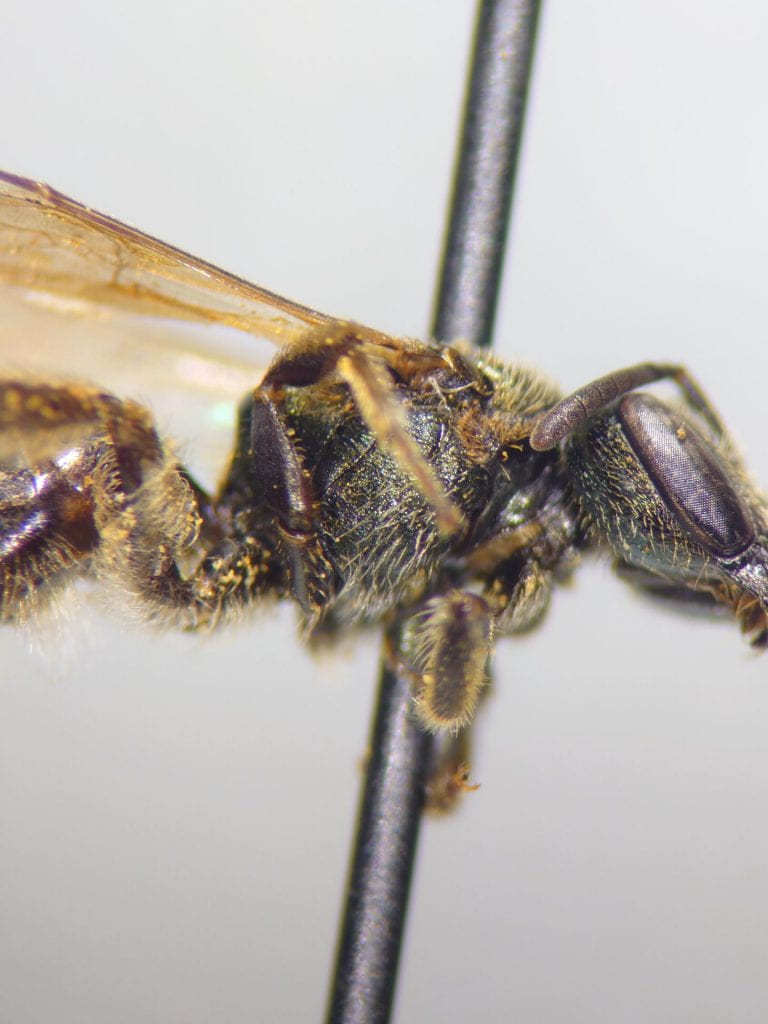

body entirely blue, t1 fan complete, scutum dense punctures laterally and sparse internally, mesepisternum without punctures, = coeruleum




Thorax bluish (or can be the normal green, so be careful), abdomen brown, scutal punctures dense laterally and sparse internally, minimal hairs on abdomen (but there ARE hairs, just not thick patches), head short, mesoscutal punctures relatively coarse, tegula dark reddish brown = oblongum
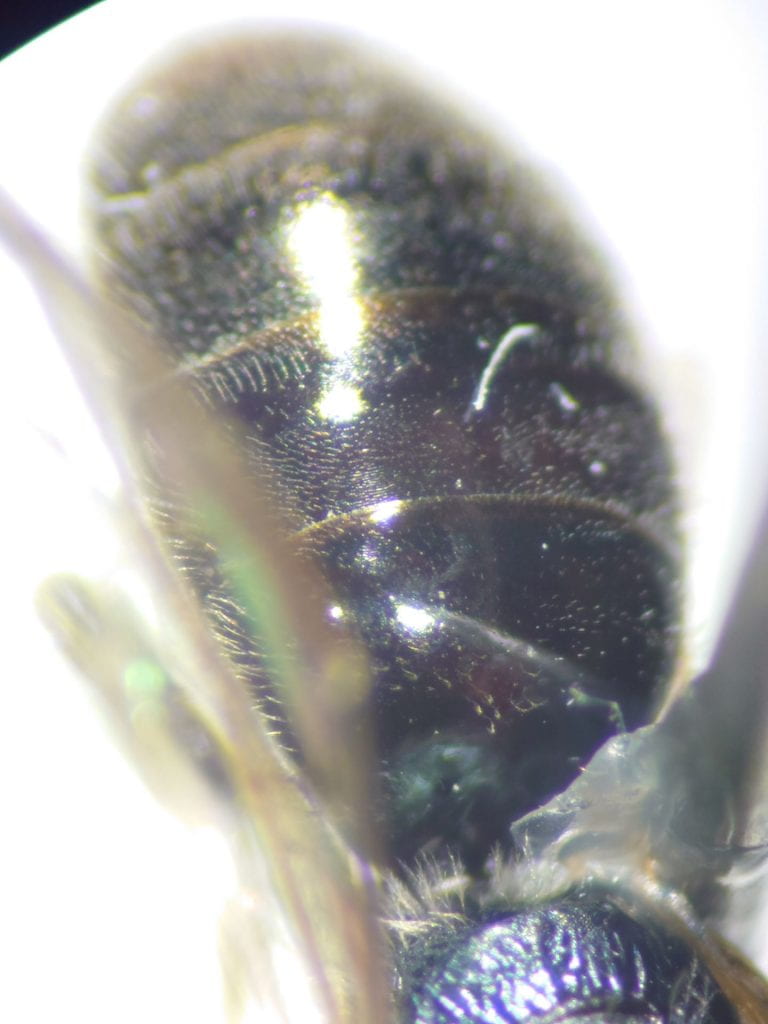





scutal punctures dense laterally and sparse internally, minimal hairs on abdomen (but there ARE hairs, just not thick patches), head short, mesosutum polished, t2 with relatively dense punctures in center and then limited punctures in apical area. as long as there are a few (albeit can look sparse and missing) on apical area then = subviridatum


Scutum dense lateral of parapsidal lines, between lines still somewhat dense but considered sparse, (be careful otherwise they will go to pilosum group), face LONG (couplet 62 in 2011 key), and abdomen metallic and t3-4 with dense white hairs, wing veins milky and wing itself somewhat milky, color of thorax slightly bluish = pruinosum
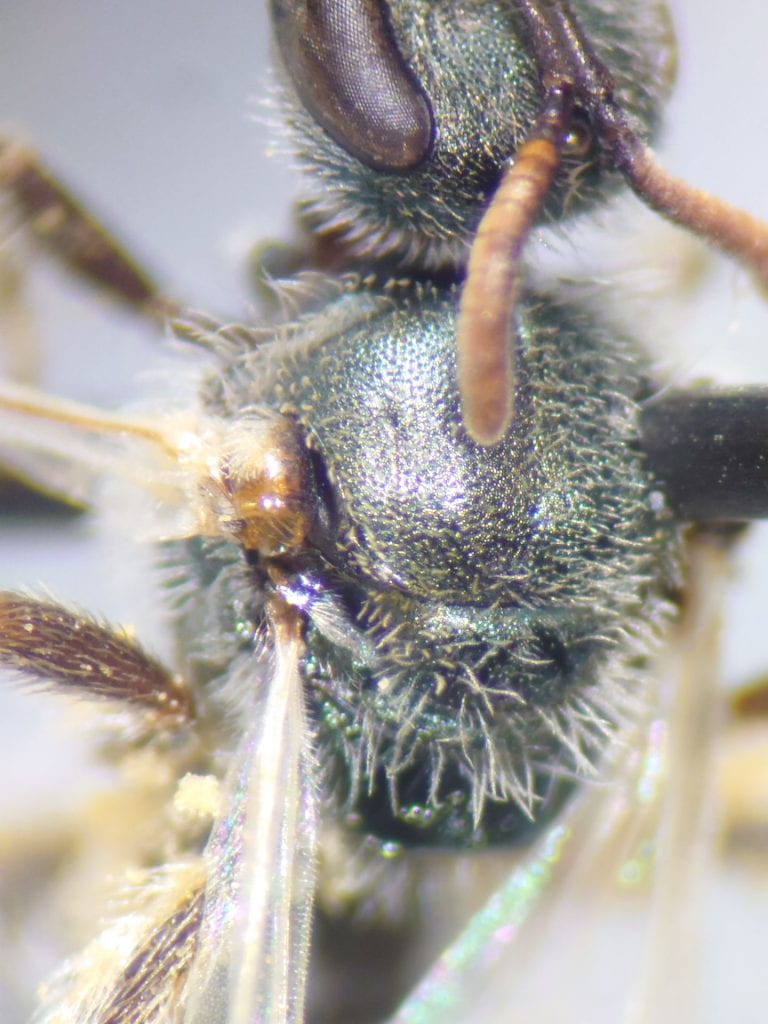

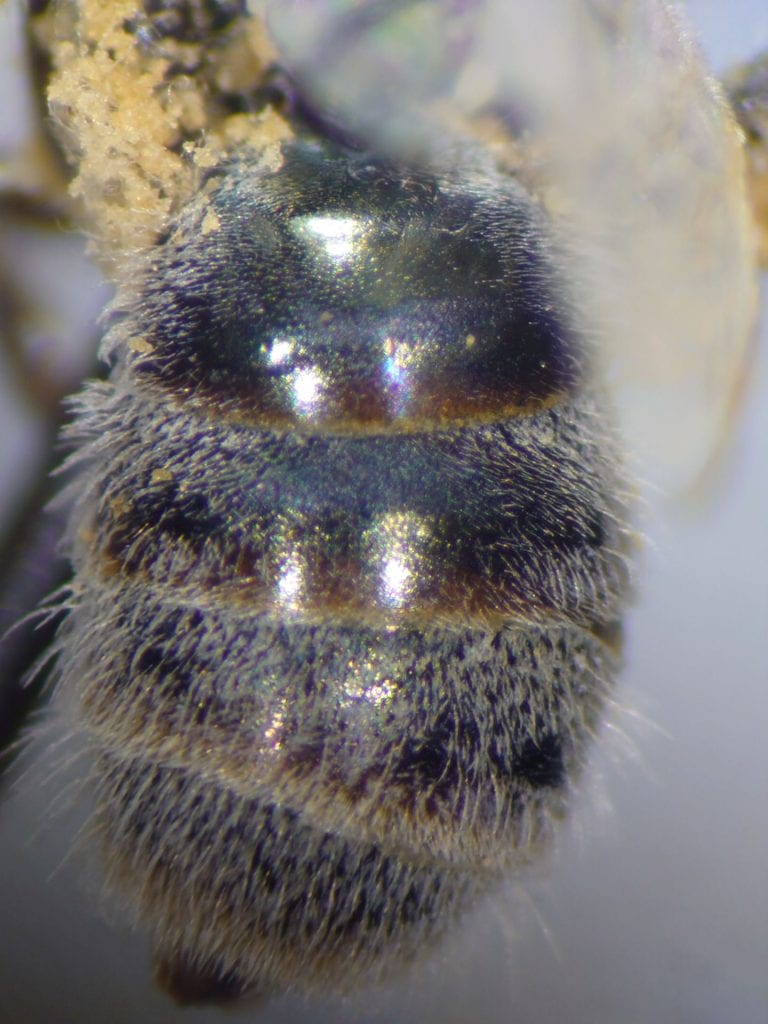
scutal punctures dense laterally and sparse internally, minimal hairs on abdomen (but there ARE hairs, in my specimen a decent amount of hair on t4, but still can see about 1/2 of integument), scutum dull, face LONG!, t2 apical area impunctate, mesepisternum impunctate = planatum



scutal punctures dense laterally and sparse internally, minimal hairs on abdomen (but there ARE hairs, in my specimen a decent amount of hair on t4, but still can see about 1/2 of integument), scutum dull, face LONG!, t2 apical area punctate LATERALLY (but I don’t see them), mesepisternum obscurely punctate, metapostnotum WITHOUT medial carinal longer than submedial rugae = taylorae (did not photograph)
Scutum dense lateral of parapsidal lines and DENSE between. Head long, metapostnotal rugae high and distinct. lateral margins of clypeus subparallel distally and pubescense yellowish = pilosum



Scutum dense lateral of parapsidal lines and DENSE between. head long, metapostnotal rugae high and distinct (higher and more distinct than pilosum). lateral margins of clypeus convergent distally and pubescense white to yellowish, wing vein milky to honeyish = leucocomum


scutum dense lateral of parapsidal lines and dense between, head long, metapostnotal rugae not particularly high and distinct, shorter and smaller, metasomal terga brownish (but with some metallic reflections), key says wings dusky but they look normal to me, key says pterostigma brown but looks tanish to me, supraclypaeual area relatively flat and DULL, t2 apical impressed area with distinct punctures, clypeus margin dark = raleighense




Scutum dense lateral of parapsidal lines and DENSE between. head WIDE; t3 with dense tomentum on most of the segment, postgena and mesoscutum polished = perpunctatum
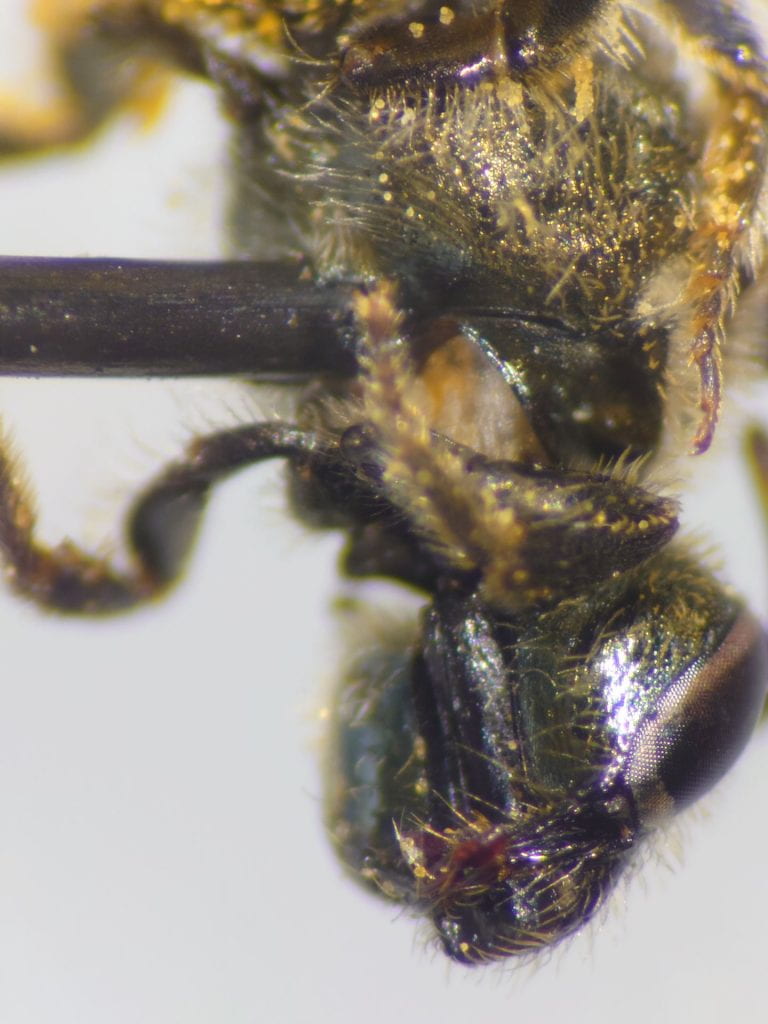



head quadrate (but seems mildly elongate to me because inner margin of eyes are practically subparallel), acarinial fan supposed to be INCOMPLETE (but my ref specimen looks complete), HYPOSTOMAL CARINA DIVERGENT towards mandibles; head wider than thorax = heterognathum (rare-ish)

acarinial fan variable, normally open and not complete like this


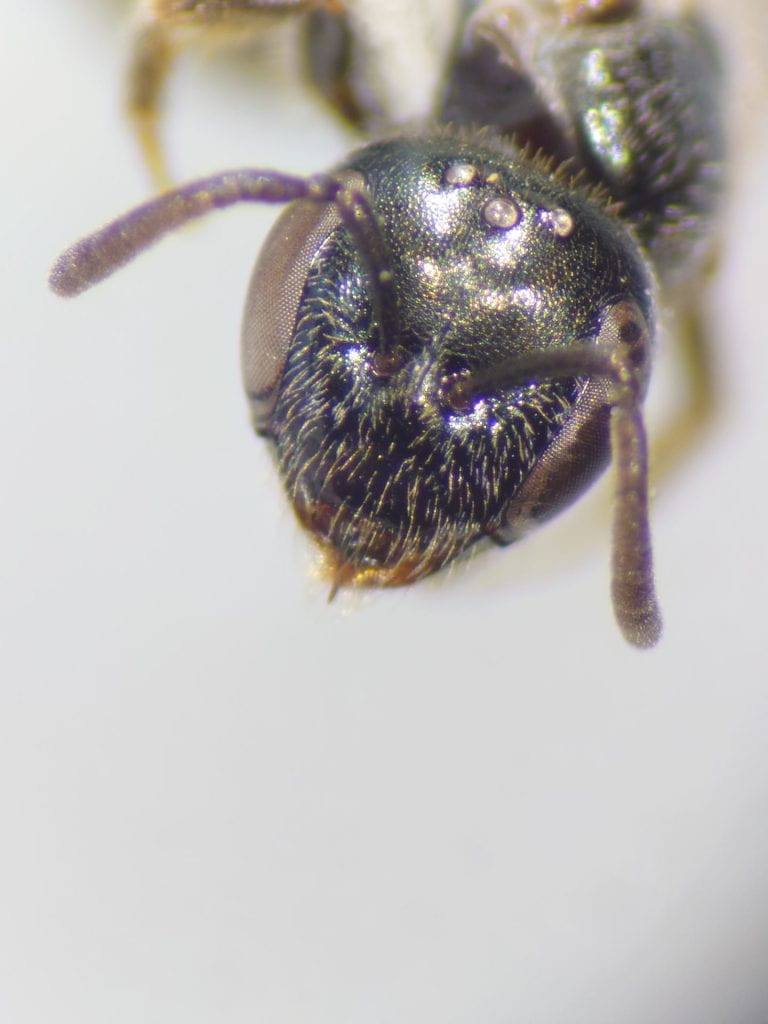

scutum punctures dense lateral of parapsidal line and sparse between, scutum shining (rules out versatum), tegulae pale yellow, mandible narrowed in center, protrochanter broad when viewed from side,t1 shiny = callidum

distinctly curved mandible
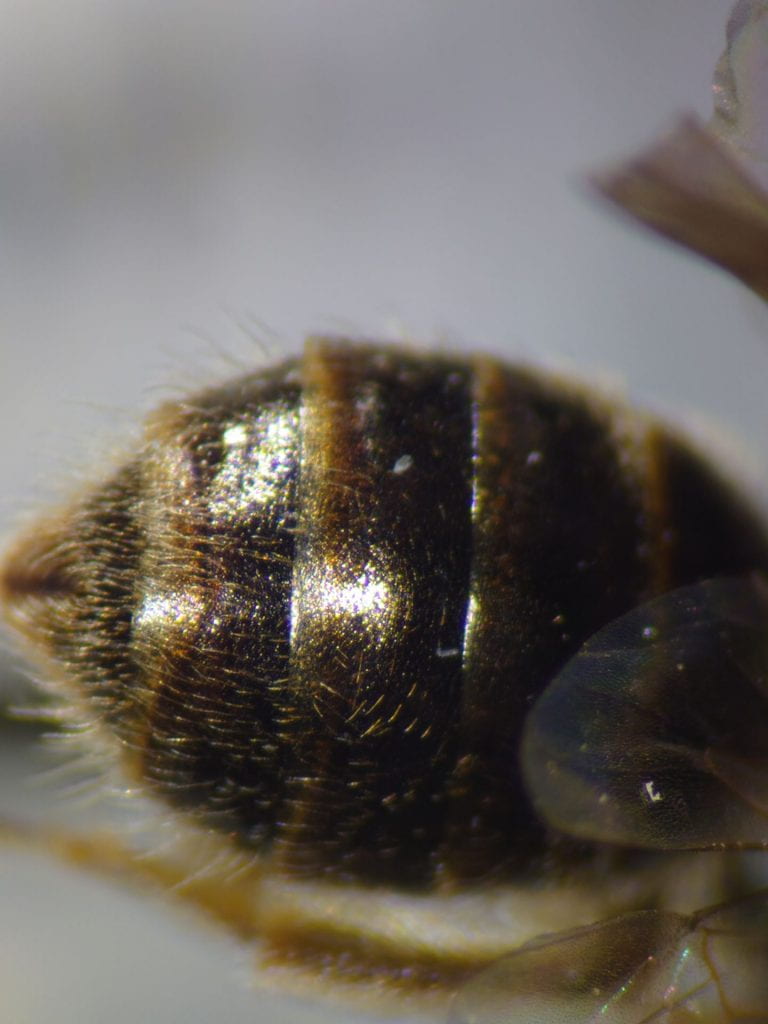

protrochantor broad

scutum punctures dense lateral of parapsidal line and sparse between, t1 fan COMPLETE, mesepisternum punctate, tibia and femora brown, metapostnotum rugae more than 2/3 distance to posterior margin, t2 apical impressed area with punctures sparse/absent, body small, 3 submarginal cells, head and mesosoma golden green = cattellae






scutum punctures dense lateral of parapsidal line and sparse between, t1 shiny, metapostnotum with rugae very short, and abdomen metallic = zephyrus


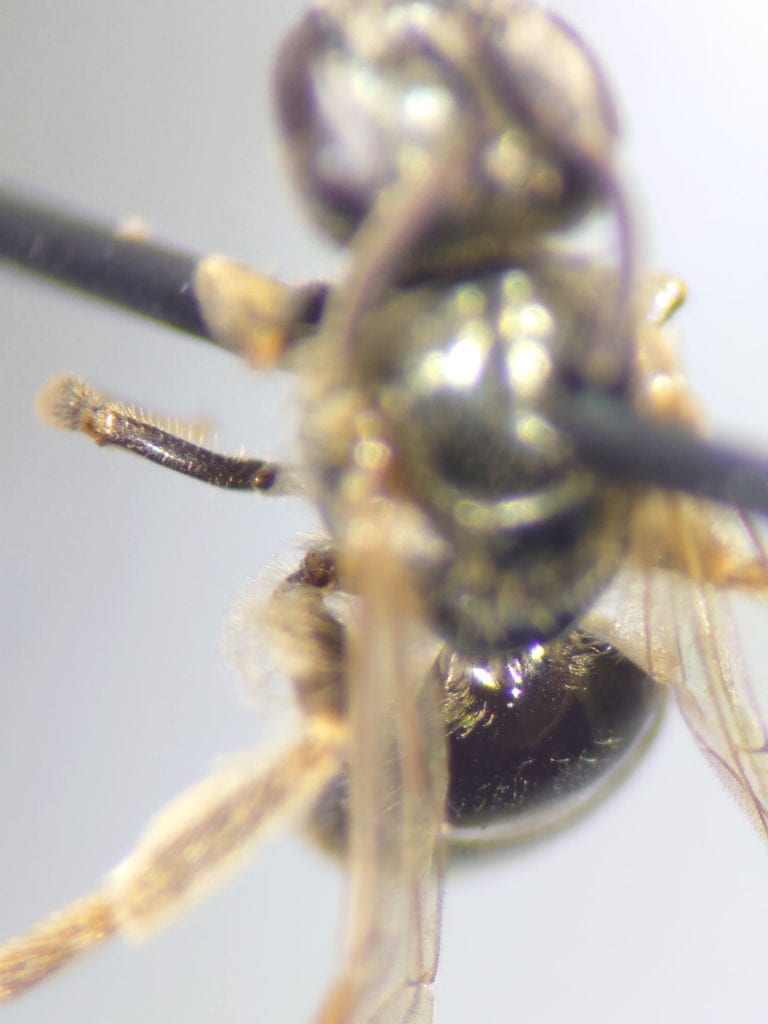

scutum punctures dense lateral of parapsidal line and sparse between, t1 fan COMPLETE, mesepisternum ruglose (not punctate), mesoscutal punctures relatively sparse, propodeum with distinct carina (so you might think this would go with the coarse propodeal group but the mesepisternum not rugose enough), propodeum with dorsolateral slope rugose and lots of hair on t3-5 = timothyi



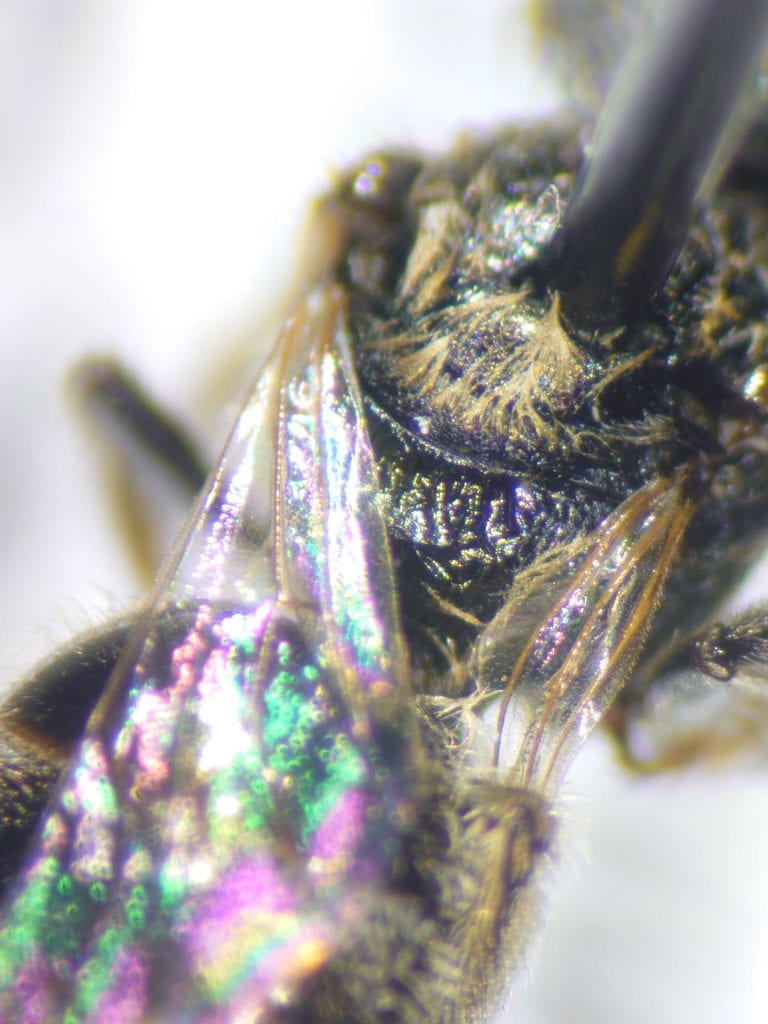

scutum punctures dense lateral of parapsidal line and sparse between, t1 fan COMPLETE, mesepisternum ruglose (not punctate), Clypeus with distal margin WIDE (rectangular!!) = mitchelli –> now hitchensi ! Dirt common bee



VERSATUM GROUP – these SUCK, but are also some of our most common specimens (did not photograph)
scutum punctures dense lateral of parapsidal line and sparse between, hairs present on t2-4, t1 shiny, t2 apical impressed area with distinct punctures, mesoscutum dull posteriorly due to microsculpture and clypeus protruding below suborbital = versatum
scutum punctures dense lateral of parapsidal line and sparse between, hairs present on t2-4, t1 shiny, t2 apical impressed area with distinct punctures, mesoscutum shining ever so slightly (hard to see this character), pale straw tegula, clypeus not protruding much below suborbital line = trigeminum??
admirandum –> Rob Jean says t2 can have very obscure punctures, see key for details. similar to versatum, but smaller in general.
sagax/ephialtum/sablense –> complex not easily differentiated??
Parasitic species: typically lack pollen collecting hairs and have excessively long mandibles
gena wider than eye, metapostnotum rugose, mandible without preapical tooth, mesepisternum rugulose, mandible wide and convergent near apex, labrum with strong basal tubercule = platyparium (did not photograph, but we have several of these)
gena wider than eye, metapostnotum rugose, mandible without preapical tooth and no tubercule = rozeni




gena wider than eye, metapostnotum SMOOTH, size small = lionotum (did not photograph)
gena wider than eye, metapostnotum with some rugae, mandible with distinct preapical tooth, mesepisternum vertically carinulate, impunctate, = michiganense

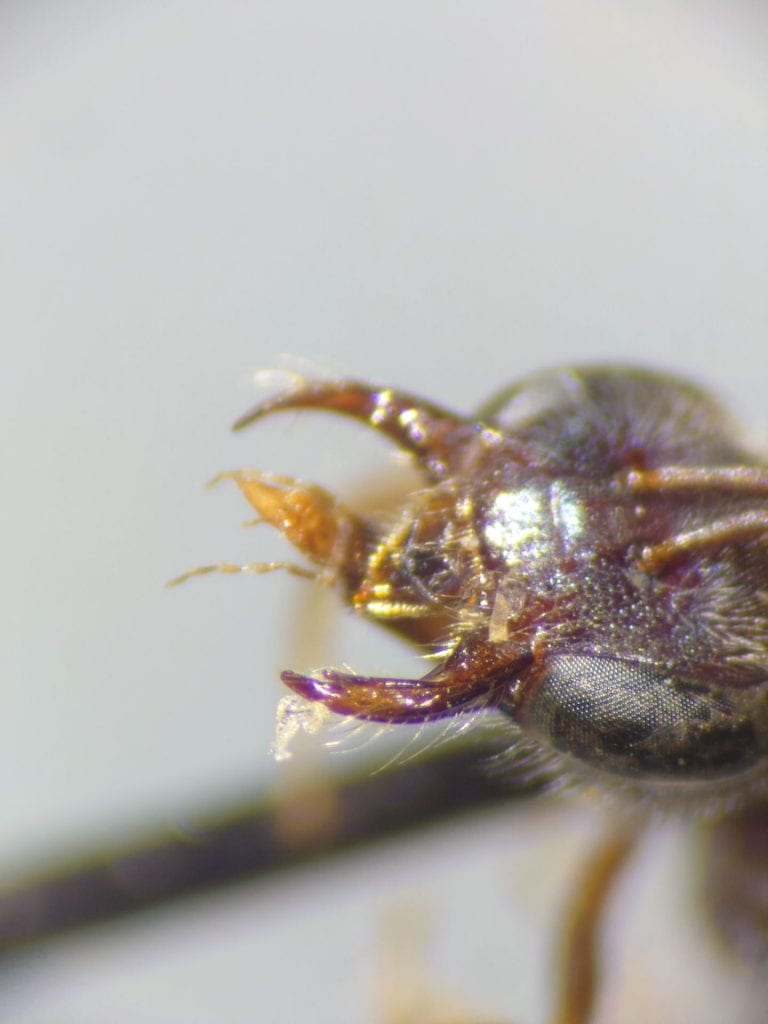

black integument group: (many more species than those listed here, we just covered a few)
Use the following key for most of the black integument species (noting that Leuchalictus and Lasioglossum subgenera are missing from this key) 2013. Revision and reclassification of Lasioglossum (Evylaeus), L.(Hemihalictus) and L.(Sphecodogastra) in eastern North America (Hymenoptera: Apoidea: Halictidae).
scutum punctate and dull, mesepisternum not coarsely rugose, pronotum with SHARP angle, inner metatibial spur pectinate, dorsolateral ridge of pronotum with carina ending before oblique sulcus = swenki
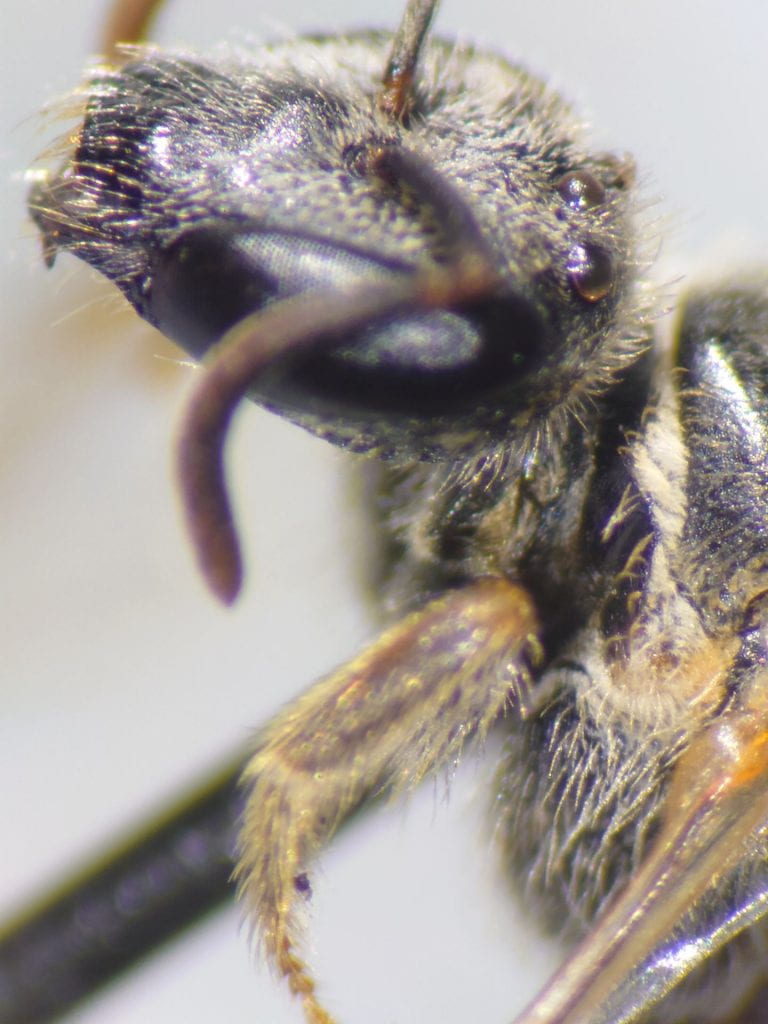





Note abdomen color variable, so some have this orange/reddish abdomen


birkmani – mesepisternum weakly punctate, pronotum rounded, head short (did not photograph)
truncatum – forgot to write characters down, see Gibbs key

distinct propodeal carina

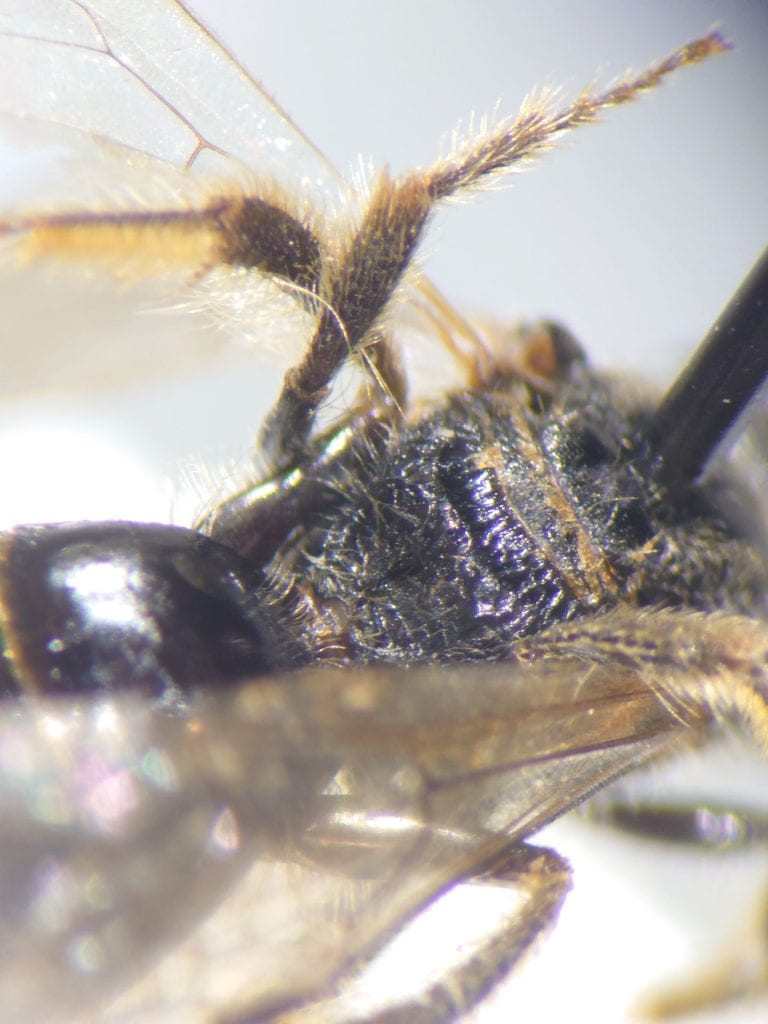
texanum – forgot to write characters down, but check out those distinctly enlarged occelli that look like blisters. See Gibbs key for characters

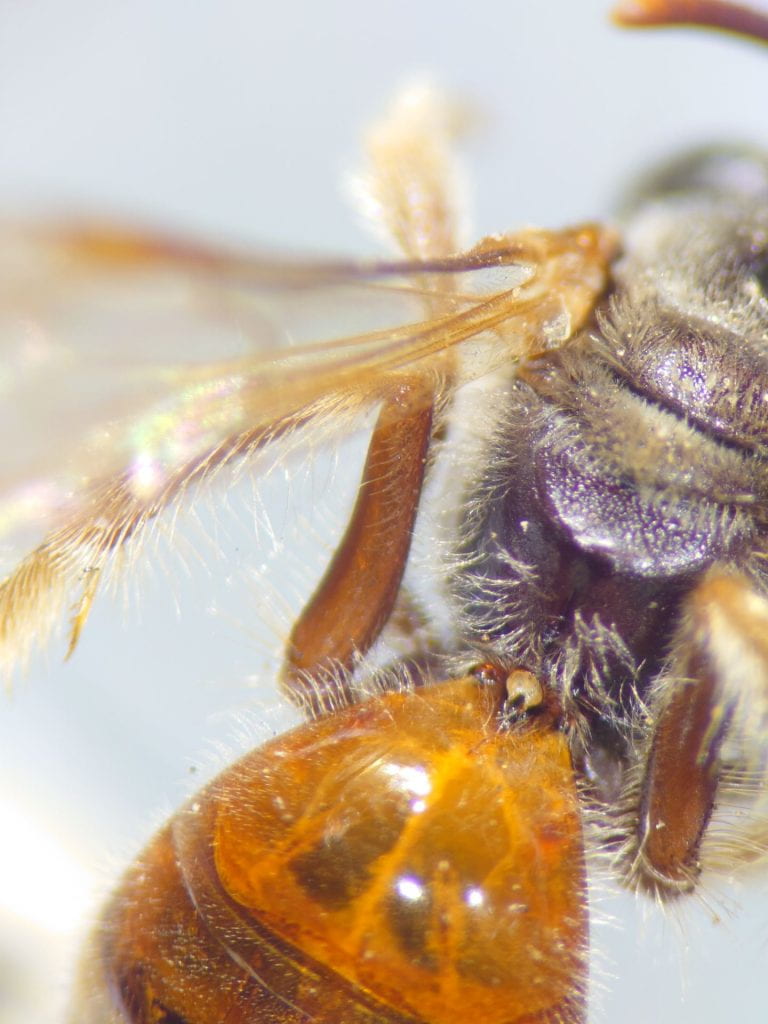

lustrans – forgot to write characters down, see Gibbs key.


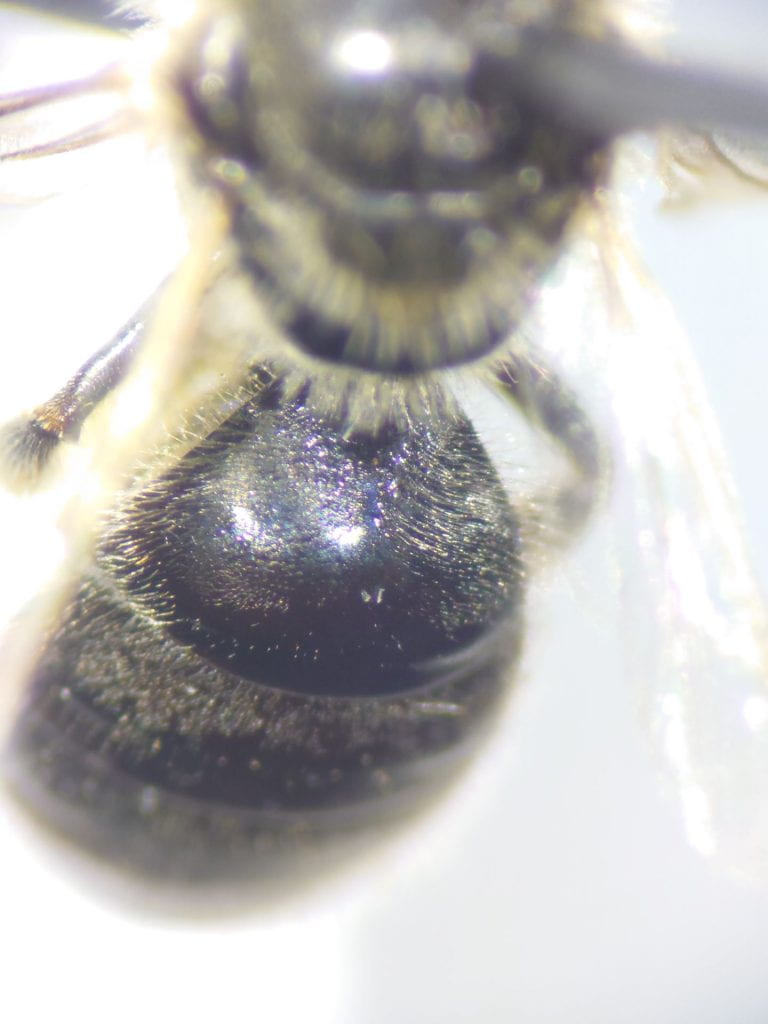

Fin. – MaLisa